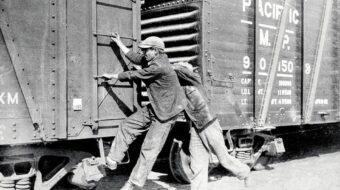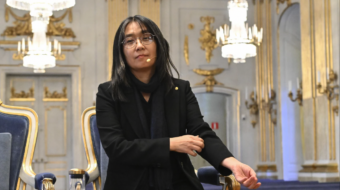
History, mysteries, novels, even vampires — some recommendations from our readers and staff.
“In the Time of the Butterflies,” by Julia Alvarez
A fictionalized biography of the Mirabel sisters and their struggle for freedom against the Dominican Republic’s dictator Raphael Trujillo. A harrowing tale, yet full of beauty, courage and inspiration.
“The Handmaid’s Tale,” by Margaret Atwood
This book is hauntingly and relentlessly depressing — but one comes to appreciate it for its allegorical significance in describing a fascistic sexist dystopia with many shadows of today’s religious ultra-right.
“Women, Race and Class,” by Angela Davis
An important book that continues to be relevant today.
“Let Their Spirits Dance,” by Stella Pope Duarte
A novel presenting the impact of the death of a Chicano youth in the Vietnam War on his family from a sister’s point of view. It captures great snapshots of barrio, working class family life in Phoenix from the 1950s to the ’90s, with a docudrama-like chapter on the 1970 National Chicano Moratorium.
“Finding Nouf,” by Zoe Ferraris
A woman born into the repressive Saudi Arabian culture is found dead in the desert. As the characters go about finding out how she died, the book shows what women face in a culture where they are required to wear burkas in public, and in their own way struggling for independence.
“Out to Work: A History of Wage Earning Women in the United States,” by Alice Kessler Harris
A valuable general history.
“The Southern Vampire Mysteries,” by Charlaine Harris
The Sookie Stackhouse series (now a show called “True Blood” on HBO). Fiction/fantasy written from a woman’s first-person point of view.
“Their Eyes Were Watching God,” by Zora Neale Hurston
The story of a woman who is raised by her grandmother after her parents disappear and who goes through three marriages in the 1930s in Florida. Despite the situations the main character faced, it shows how she was determined to get through it.
“Labor of Love: Labor of Sorrow: Black Women, Work and the Family from Slavery to the Present,” by Jacqueline Jones
The title pretty much explains what this excellent book is about.
“The Heretic’s Daughter,” by Kathleen Kent.
The author, whose ancestor was killed in the Salem witch trials in the 17th century, describes what life was like for women and how the hysteria came about through the eyes of her relative.
“The No. 1 Ladies’ Detective Agency,” by Alexander McCall Smith.
A series set in Botswana describing the life of Precious Ramotswe after her father dies and she gets rid of an abusive husband. Each book has its own story with the characters continuing from novel to novel. It’s a fun read.
“Reading Lolita in Tehran,” by Azar Nafisi.
A memoir by an Iranian English literature teacher just before, during and after the Islamic Revolution of 1979. Difficult at times to confront the political realities of the day.
“Packinghouse Daughter: A Memoir,” by Cheri Register
A girl growing up blue-collar and union during a bitter strike in a company town. A wonderful book about how a young woman learns what it means to be working class.
The Kate Shugak series, by Dana Stabenow (“A Cold Day for Murder,” “A Fatal Thaw,” “Dead in the Water,” “A Cold-Blooded Business” and a dozen other titles)
These mysteries, set in a 20-million-acre Alaskan wilderness known affectionately as “The Park,” are a refreshing antidote to Sarah Palin. Their main character is the tough, smart, short Kate Shugak, an Aleut woman (with Russian and other roots) who lives alone (with her half-husky, half-wolf dog, Mutt) and solves crimes in which the criminals often have some connection to corporate corruption or private exploitation of Alaska’s resources. A touch of the mystical, the powerful beauty of nature, plus some good-sense politics make these really good reads.
“Women Strike for Peace: Traditional Motherhood and Radical Politics in the 1960s,” by Amy Swerdlow
A historical account of this groundbreaking women’s movement by a founding member of WSP. It tells the story of a significant chapter in American politics and the emerging movement for women’s equality.
“Winter Wheat,” by Margaret Walker
Originally published in 1944, this beautiful novel is the story of a young woman coming of age in Montana’s harsh wheat country. It depicts her struggle to find her way as an independent woman and come to terms with her parents, and gives a sense of what that struggle was like for women growing up in that period, out on the plains.
“Class Action, The Story of Lois Jenson and the Landmark Case That Changed Sexual Harassment Law,” by Clara Bingham and Laura Leedy Gansler
This gripping page-turner is the true story of a group of women iron ore workers in Minnesota’s Iron Range who overcame intimidation and fear to challenge sexual harassment on the job. Their case, Jenson vs. Eveleth Mines, was the first sexual harassment class action in the U.S. It permanently changed the legal landscape as well as the lives of the women who fought the 25-year battle. One of the women was the niece of legendary Minnesotan and Communist Party USA leader Gus Hall. This book was the basis of the movie “North Country,” which was good, but the book is better!
Some recommendations for young people:
For girls 7-12 years old: the American Girl Collection, by various authors. The books in this series offer fictional stories of the lives of girls during a variety of historically significant epochs. For example:
“Meet Josefina,” by Valerie Tripp tells the story of a girl growing up in Santa Fe in 1824.
Several for young people 10 and over:
“100 Women Who Shaped World History,” by Gail Meyer Rolka
Short introductions to 100 women who have shaped history in positive and negative ways. Examples include Eleanor Roosevelt, Amelia Earhart, Helen Keller and many others.
“Girls Think of Everything — Stories of Ingenious Inventions by Women,” by Catherine Thimmesh, illustrated by Melissa Sweet.
Full of interesting stories of women (and girls!) who have invented many things we use today.
“We Were There, Too! Young People in U.S. History,” by Phillip Hoose
Gives insight into how young people have helped shape the history of our country. Many of the stories are about girls and young women.
— Teresa Albano, Elaine Lantz, Norman Markowitz, Elena Mora, Rosalio Muñoz, Matt Parker, Rosemarie Rieger, Susan Webb, Carl Wood











Comments